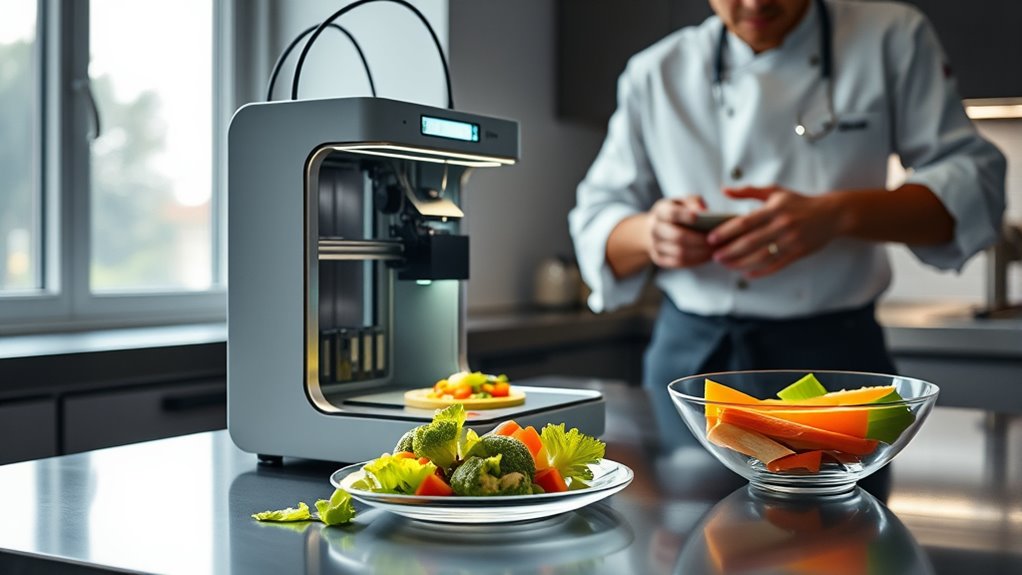By embracing 3D food printing, you can actively minimize kitchen waste and boost sustainability. The technology allows you to create precisely portioned, creative meals from eco-friendly ingredients like plant-based proteins and reclaimed produce. It helps reduce scraps, overproduction, and leftovers while offering artistic plating options. This smarter approach turns food into an artful resource, fostering responsible cooking habits. To discover how to implement these innovative techniques, keep exploring the exciting possibilities of zero-waste culinary practices.
Key Takeaways
- 3D food printing minimizes waste by using precise portioning and repurposing leftover ingredients.
- Incorporates sustainable ingredients like plant-based proteins and reclaimed produce to reduce environmental impact.
- Enables creative, intricate plating that enhances presentation and encourages mindful consumption.
- Supports customization to meet dietary needs, preventing uneaten food and reducing waste.
- Promotes eco-friendly kitchen practices aligned with zero-waste principles through technological innovation.

As sustainability becomes more urgent, 3D food printing offers an innovative way to reduce waste in the kitchen. Instead of discarding leftover ingredients or overproducing, you can use the technology to transform sustainable ingredients into precisely portioned, appealing dishes. This approach minimizes food scraps and ensures every bit of your ingredients gets used efficiently. You select your sustainable ingredients—such as vegetable purees, nut pastes, or protein extracts—and feed them into the 3D printer. The device deposits these materials layer by layer, allowing you to create complex shapes and textures that might be difficult with traditional cooking methods. This precision not only cuts waste but also enhances presentation, making your dishes visually stunning through innovative plating techniques.
3D food printing reduces kitchen waste by transforming sustainable ingredients into precisely portioned, visually stunning dishes.
By leveraging 3D food printing, you gain control over portion sizes, reducing leftovers and preventing over-preparation. Instead of bulk cooking, you can print exactly what’s needed for each meal, eliminating excess. This is especially useful when working with seasonal or locally sourced ingredients, which often come in limited quantities and need careful management. The use of sustainable ingredients—like plant-based proteins, algae, or reclaimed produce—further supports eco-friendly practices. You can experiment with different combinations to develop new flavors and textures, all while respecting environmental concerns.
The technology also opens doors to creative plating options. You can craft intricate patterns, layered designs, and artistic presentations that elevate the dining experience. This innovative plating not only excites the eye but also encourages mindful eating, as diners appreciate the effort and ingenuity behind each dish. As you become more adept, you might develop signature styles that integrate sustainability and art, reinforcing your commitment to zero-waste principles.
Additionally, 3D food printing simplifies the process of creating customized meals for specific dietary needs or preferences, reducing waste caused by uneaten food. Instead of preparing multiple versions of a dish, you can print variations tailored to individual tastes. This flexibility means less food is thrown out and more is enjoyed. Incorporating food waste reduction strategies into your kitchen through 3D printing can significantly impact your environmental footprint. As you incorporate this technology into your kitchen, you’ll find that it transforms how you view food—no longer just fuel but a resource to be optimized, celebrated, and shared through innovative plating and sustainable ingredients. It’s a practical step toward a zero-waste future, where technology empowers you to cook smarter and more responsibly every day.
Frequently Asked Questions
Can 3D Food Printers Replicate Traditional Cooking Textures?
Yes, 3D food printers can replicate traditional cooking textures, thanks to advancements in texture fidelity technology. You can enjoy a wide ingredient variety, allowing the printer to create complex textures like crispy exteriors or creamy interiors. While it might not perfectly mimic every nuance of handcrafted dishes, it comes impressively close, especially for zero-waste cooking, offering innovative ways to enjoy familiar textures with less waste and more precision.
What Are the Environmental Impacts of 3D Food Printing?
Think of 3D food printing as planting a seed for sustainability. It reduces waste by using precise ingredients, lowering your environmental footprint. While it promotes sustainable packaging, it does consume energy, which can impact the environment. By optimizing energy use and embracing eco-friendly materials, you help guarantee this innovative technology nurtures rather than harms our planet, making your culinary choices a powerful act of environmental stewardship.
Is Zero-Waste Cooking With 3D Printing Cost-Effective?
Yes, zero-waste cooking with 3D food printing can be cost-effective. You’ll find that a thorough cost analysis shows savings through waste reduction, as you use only the precise amount of ingredients needed. Plus, it minimizes leftover scraps and packaging waste, lowering overall costs. Though initial setup might be pricey, the long-term benefits of reduced waste and efficient ingredient use make it a smart, economical choice in the long run.
How Accessible Are 3D Food Printers for Home Use?
3D food printers for home use are becoming more accessible, but cost barriers still exist for many. While newer models are designed to be more user-friendly, they can be pricey and require some technical know-how. If you’re enthusiastic to explore zero-waste cooking, consider starting with simpler, more affordable options or DIY kits. As technology advances, expect these devices to become more affordable and easier to operate for everyday home chefs.
Are There Health Concerns With 3D Printed Edible Ingredients?
A stitch in time saves nine, so you should be cautious with 3D printed edible ingredients. While most printers use food-grade materials, there are concerns about nutritional safety and potential ingredient contamination. Always verify the printer and ingredients are properly sanitized. If you follow safety guidelines, the health risks are minimal. Be vigilant and prioritize quality to enjoy innovative, safe, zero-waste cooking experiences.
Conclusion
By embracing 3D food printing, you can drastically reduce food waste and create innovative meals. Did you know that up to 40% of food produced globally is wasted? Imagine cutting that waste in half with this technology. Every meal you make using 3D printing not only minimizes leftovers but also contributes to a more sustainable future. So, start experimenting and help turn the tide against food waste—your choices can make a real difference.








